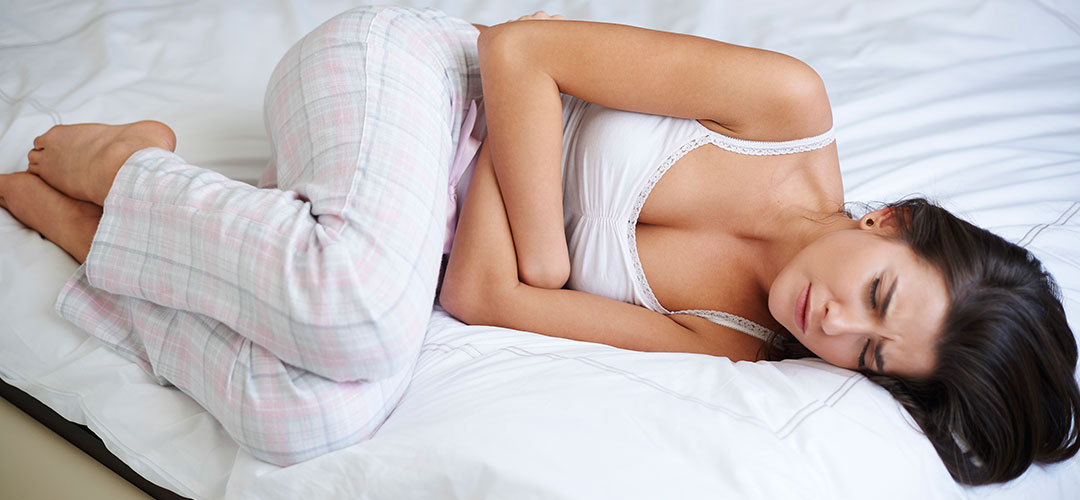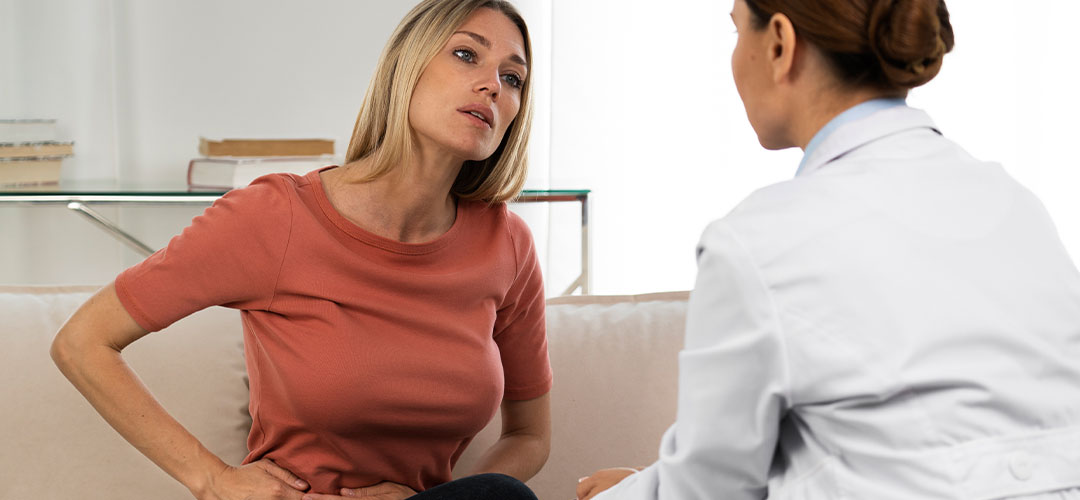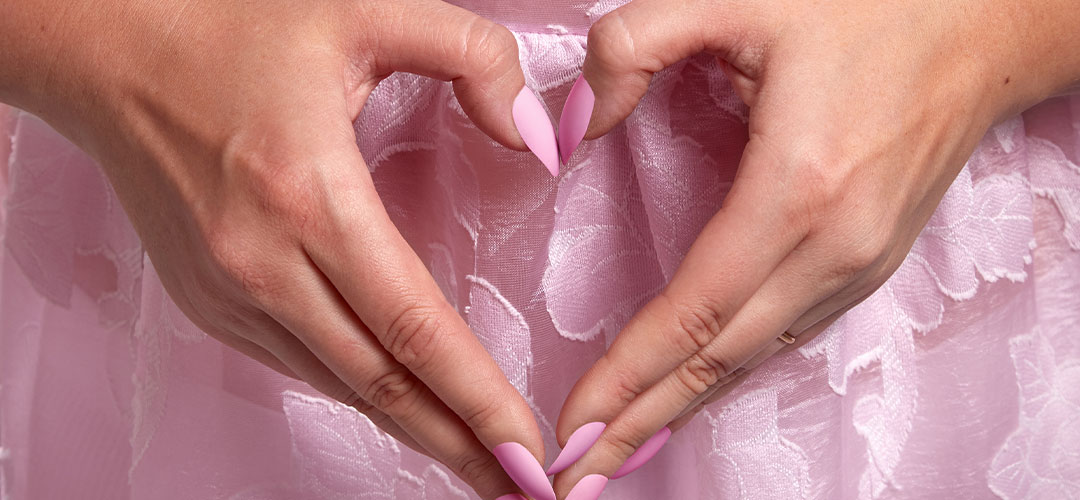
Endometriosis is a chronic inflammatory disease, more common in childless women over the age of 30, that impacts around 1.5 - 2 million women in the UK.
[1] Worldwide figures suggest around 10%-15% of females of reproductive age are impacted.[2] Because it is hard to diagnose, with symptoms varying considerably, and other conditions causing similar symptoms, the actual figure of women with endometriosis is likely to be even higher.
Research suggests that endometriosis is sensitive to the female hormone oestrogen. Women that have had more menstrual cycles without having a break for pregnancy, will have experienced more exposure to these hormones. With an increasing number of women delaying pregnancy into their later years, or not having children at all, the incidence of endometriosis has the potential of increasing.
• What is it?
Endometriosis is a condition where cells similar to those found in the lining of the womb (uterus) grow elsewhere in the body. It often involves pelvic tissue which can surround the fallopian tubes. It can also impact nearby organs, such as the bowel and bladder.
During the menstrual cycle, the body experiences monthly changes where the release of hormones causes the lining of the womb to increase in preparation for a fertilised egg. If the egg remains unfertilised, the lining breaks down and the blood is released as a period.
In endometriosis, the similar cells that grow outside of the womb lining are also impacted by hormones. The hormones cause the formation of tissue, which thickens, breaks down and bleeds with the menstrual cycle. The body releases the blood, very slowly, unlike a period. Endometriosis causes the surrounding tissues to become irritated and potentially causes scars and fibres that bind tissues together. In some cases, it can also result in cysts on the ovaries.
• What are the symptoms?
The symptoms vary between women in severity: they can be experienced at any time of the menstrual cycle. Some women experience no symptoms at all.
According to the National Institute for Health and Care Excellence, the symptoms include:
-
- Chronic pelvic pain (for a minimum of 6 months of cyclical or continuous pain)
- Period-related pain (dysmenorrhoea) that impact daily activities and quality of life
- Intense pain during or after sex
- Period-related or cyclical gastrointestinal symptoms, in particular, painful bowel movements
- Period-related or cyclical urinary symptoms, such as blood in the urine or pain when passing
urine - Infertility in association with 1 or more of the above. [3]
Other symptoms include a lack of energy and fatigue, [4] shortness of breath, [5] spotting or bleeding during menstrual periods [6] and potential anxiety and depression due to long-term pain. [7]
Symptoms are reported to decline noticeably after pregnancy in some women with the assumption being that a break in the monthly cycle lessens the disease.
• What causes endometriosis?
Very little is known about the causes for who gets endometriosis and despite many theories being researched, none have been conclusively confirmed.[8] The oldest established theory, retrograde menstruation, suggests it could be due to ectopic growth of endometrial tissues ‘regurgitated' during menstrual cycles’[9] and that stem cells play a role in this process. However, this theory does not account for the fact that retrograde menstruation occurs in 76%-90% of women with patent (open) fallopian tubes and not all of these women will have endometriosis, thus is inconclusive.[10]
Another theory proposed is that endometriosis is caused by Coelomic metaplasia which suggests that peritoneal cells could transform into an endometrial cell in response to certain stimuli, such as hormones, the environment or in response to an inflammatory process. This theory also remains inconclusive.
That there are so many theories involved in the study of endometriosis and that they remain currently inconclusive,[11] demonstrates that its causes are complex, due to many factors that involve hormonal, genetic, immune and environmental components.
• Who gets endometriosis?
Despite the lack of clarity of the causes of endometriosis, there are some factors that make it more likely for a woman to get it:
-
- Never giving birth
- More frequent menstrual cycles than the average 28 days
- Heavy and prolonged menstrual cycles that last longer than 7 days
- Higher levels of oestrogen
- Low Body Mass Index
- Structural issue with the vagina, uterus or cervix that prevents the passage of blood during the menstrual cycle
- A family history of endometriosis
- Starting your period at an early age
- Starting menopause at an older age.[12]
• Treatment – medical management of pain
The medical management of endometriosis seeks to reduce inflammation, suppress ovarian cycles and inhibit the effect of oestrogen. Options include over the counter pain killers, hormone treatments (in the form of contraceptives), or surgery.
Surgical procedures include a laparoscopy or laparotomy, depending on the severity of the case. The procedures identify patches, which are then either removed or destroyed. Another option to someone who does not want to have children is a hysterectomy, where the womb, and sometimes ovaries, are removed. However, the procedures mentioned above cannot resolve the likelihood of the recurrence of endometriosis and unfortunately, for many women, the disease remains, negatively impacting their fertility and quality of life.[13]
• The role of diet and supplements in the treatment of endometriosis
Variations in cases of endometriosis among regions, countries and populations might be explainable by difference in lifestyle, environmental factors (such as exposure to the sun) and diet, in addition to genetic explanations of the causes of the disease.
Although diet alone cannot always enable the body to heal from endometriosis, the correct dietary changes may support in reducing inflammation, resulting in a reduction or the elimination of pain. These foods include ingredients that are rich in antioxidants and omega-3 fatty acids, such as fruits, vegetables, nuts, seeds and fatty fish. An adjustment to diet by removing, for example, gluten, milk, refined sugar and table salt/salty foods (not Celtic or Himalayan salt, which is beneficial) could improve symptoms in some women who have gastrointestinal complaints and endometriosis.
An exciting area of research is in the role of phytoestrogens in the treatment of endometriosis. The word phytoestrogen comes from the Greek word phyto, or plant, and oestrogen, the hormone that causes fertility in female mammals. They are known as dietary oestrogens as they are not created in the body, but created by plants. There are many types of foods containing these naturally occurring oestrogens that may positively impact endometriotic tissues, such as soybeans, sprouts, beans, cabbage, soy-related products, fruits and oil seeds.[14]
Phytoestrogens have the ability to both mimic oestrogen and act as an oestrogen antagonist, meaning they both copy and behave in the opposite way of oestrogen found in the body. They affect the body by attaching to oestrogen receptors.[15] Why is this important? Endometriosis growth is stimulated by oestrogen; phytoestrogens produce anti-oestrogenic activity in high-oestrogen environments, such as endometriosis, therefore balancing hormone levels.
Extensive international research has shown that phytoestrogens are able to regulate the expression of key endometriosis-related genes as well as modify the disease’s processes, including inflammation and the spreading and invasion of endometriotic cells.[16] Eating foods that help remove oestrogen and prevent levels from getting too high, may be beneficial. Eating fibre-rich foods can help to remove oestrogen out of the body through bowel movements. Fibre-rich foods include fruits, vegetables, nuts, seeds and legumes.

• Systematic Kinesiology – a holistic approach to endometriosis
Systematic Kinesiology has supported countless women with endometriosis to move beyond their symptoms and live a pain-free life. In many cases, kinesiology has helped women who thought they could never have children, to have a family. So, what is kinesiology? How does it work and why is it so successful in treating women with endometriosis?
• What is Systematic Kinesiology?
Systematic Kinesiology is a natural health care system that uses muscle testing to evaluate the functions of the body. It works from the perspective that different muscles relate to different organs and bodily systems and therefore the strength or weakness of every muscle is connected to the health or lack of health of a specific corresponding organ. Muscle testing locates mental stress, nutritional deficiencies and sensitivities, structural issues and energetic imbalances.
Layla Auer
Systematic Kinesiology Practitioner
A case study
Sydney[17] came to me for her first treatment in March 2023. She had never experienced natural health care before and was open to trying anything that might help. Recently turned 21, she started to suffer from erratic bleeding two years ago.
Concerned, she sought help from her doctor. They suggested she try the contraceptive pill, then the implant and when they failed to alleviate her issues, the contraceptive injection. None of these suggestions got to the root of the problem and instead made her feel worse, hormonally imbalanced and nowhere closer to understanding what was happening to her.
Not feeling heard by the medical world, let alone believed, she struggled through, worried about her future which included having a family. In fact, that was one of the most stressful aspects of her visits to the doctors, that nobody believed the extent to which she was suffering and took appropriate action.
Eventually, after she received a diagnosis of endometriosis in Autumn 2022. Finally, a diagnosis and with that presumably a solution. She agreed to have surgery and had a laparoscopy to remove the patches of endometriosis.
After the operation she had a contraceptive coil fitted and initially, her symptoms stopped. She ceased menstruating, and along with that the intense pains she’d had also stopped. It seemed like the surgery had been successful and normal life resumed. However, a few months later Sydney started bleeding erratically again, being woken up with chronic pelvic and abdominal pain and her dreams of being a mother felt threatened again.
• Sydney’s first treatment
Through muscle testing, I found some sex hormone muscles and stress-related systems that were weak and needed support. We identified which emotions were connected with her hormonal imbalances, as there is always an emotional component to disease. I then tested a combination of plants that contain phytoestrogens and Lily and Loaf’s Soya Protein with Vitamins and Minerals, a protein powder containing soy protein and the full range of amino acids needed by the body, to see whether they would help rebalance her hormone levels naturally. The combination of ingredients and Lily and Loaf’s Omegas 3-6-9 1000 mg muscle tested as essential for her to take in connection to her hormonal imbalance.
After her initial treatment, she was advised to follow the protocol of having a shake made up of certain fruits, soy yoghurt and flax seeds and take omega oils every morning for two weeks, then to stop for two weeks and resume for two weeks, until the symptoms abated.
• Four weeks later
Sydney returned for her follow-up and reported that she felt a lot better. Despite struggling with some of the textures in the shake, she had been following the protocol as best she could and within two weeks felt a noticeable reduction in pain. She felt inspired to make dietary and lifestyle changes and that she was taking her health into her own hands, with immediately obvious positive results.
• Sydney’s third treatment
In her third treatment, she was baffled and thrilled. She was completely pain free! How could kinesiology, a plant-based shake and some supplements have worked, and so fast?
She said: “I wish everyone who had experienced the nightmare of endometriosis knew about kinesiology. I can’t understand how this has worked, but it has, and that’s all that matters to me.”
• The hormone balance shake and other hormone-related issues
The hormone shake is not only effective in supporting people experiencing endometriosis but can be used for a whole range of hormonal imbalances. According to Claire Muller, Systematic Kinesiology tutor, practitioner and principal of The Academy of Systematic Kinesiology:
“In my experience over 35 years this shake balances out the female hormones (which will be biochemically different for each person) to enable the body to heal from all kinds of hormonal imbalances. It’s nature’s miracle for inexplicable infertility, menopause, pre-menstrual syndrome, mid-cycle spotting, long cycle periods, short cycle periods and/or bleeding continuously. I have seen all these conditions be rectified for my clients.’
What to do next
If you are experiencing hormonal imbalances and want them to stop, naturally, then do not hesitate to get in touch.
(CLICK HERE).
[1] https://www.endometriosis-uk.org/what-endometriosis
[2] https://www.healthline.com/nutrition/endometriosis-diet-tips
[3] https://cks.nice.org.uk/topics/endometriosis/diagnosis/when-to-suspect-endometriosis/
[4] https://www.nichd.nih.gov/health/topics/endometri/conditioninfo/symptoms
[5] https://www.npr.org/sections/health-shots/2023/07/16/1186533247/endometriosis-a-painful-and-often-overlooked-disease-gets-attention-in-a-new-fil
[6] https://www.hopkinsmedicine.org/health/conditions-and-diseases/endometriosis
[7] https://www.bupa.co.uk/health-information/womens-health/endometriosis
[8] Samer Sourial, Nicola Tempest, and Dharani K. Hapangama (2014) Review Article Theories on the Pathogenesis of Endometriosis Hindawi Publishing Corporation International Journal of Reproductive Medicine Volume 2014, Article ID 179515, accessed online: http://dx.doi.org/10.1155/2014/179515
[9] Cai X, Liu M, Zhang B, Zhao SJ, Jiang SW. Phytoestrogens for the Management of Endometriosis: Findings and Issues. Pharmaceuticals (Basel). 2021 Jun 14;14(6):569. doi: 10.3390/ph14060569. PMID: 34198709; PMCID: PMC8232159.
[10] Samer Sourial, Nicola Tempest, and Dharani K. Hapangama (2014) Review Article Theories on the Pathogenesis of Endometriosis Hindawi Publishing Corporation International Journal of Reproductive Medicine Volume 2014, Article ID 179515, accessed online: http://dx.doi.org/10.1155/2014/179515
[11] This article has a comprehensive review of theories on the potential causes of endometriosis: https://www.hindawi.com/journals/ijrmed/2014/179515/
[12] https://www.mayoclinic.org/diseases-conditions/endometriosis/symptoms-causes/syc-20354656
[13] Cai, Xia, Min Liu, Bing Zhang, Shao-Jie Zhao, and Shi-Wen Jiang. 2021. "Phytoestrogens for the Management of Endometriosis: Findings and Issues" Pharmaceuticals 14, no. 6: 569. https://doi.org/10.3390/ph1406056
[14] https://www.endonews.com/phytoestrogens-could-have-promising-effects-in-endometriosis-management
[15] https://draxe.com/nutrition/phytoestrogens/
[16] Cai, Xia, Min Liu, Bing Zhang, Shao-Jie Zhao, and Shi-Wen Jiang. 2021. "Phytoestrogens for the Management of Endometriosis: Findings and Issues" Pharmaceuticals 14, no. 6: 569. https://doi.org/10.3390/ph1406056
[17] Sydney gave permission to have her real name included in this article.




